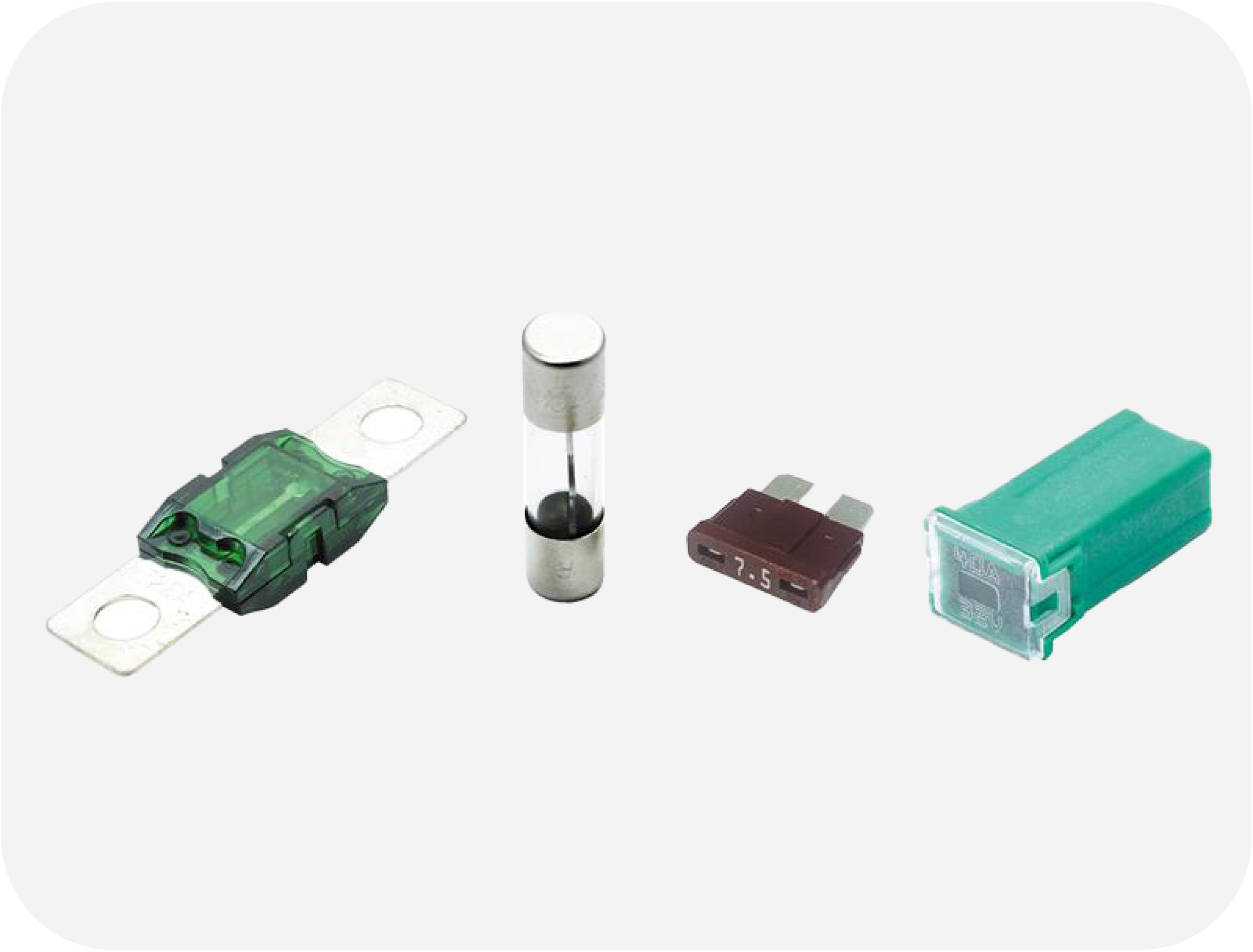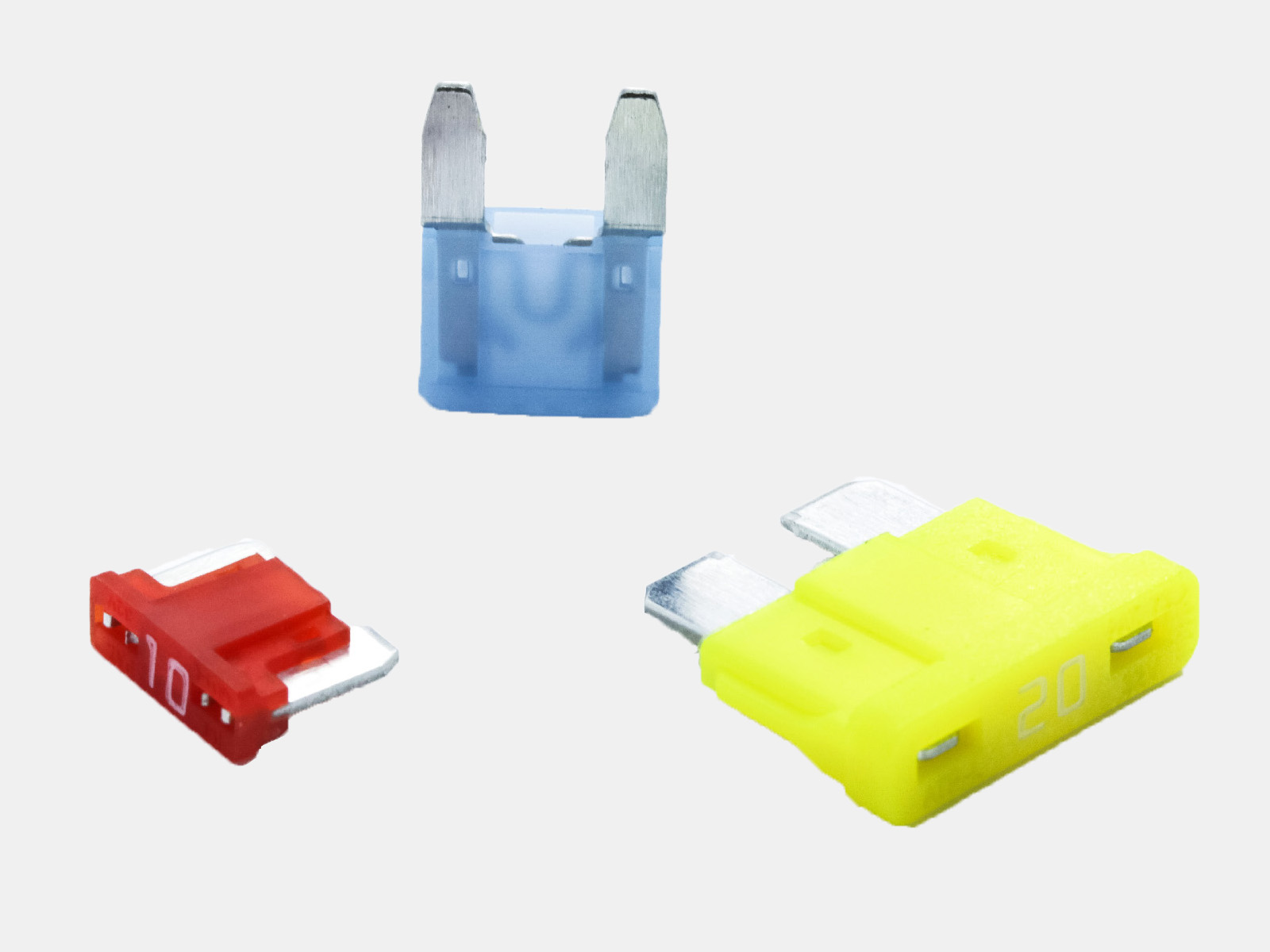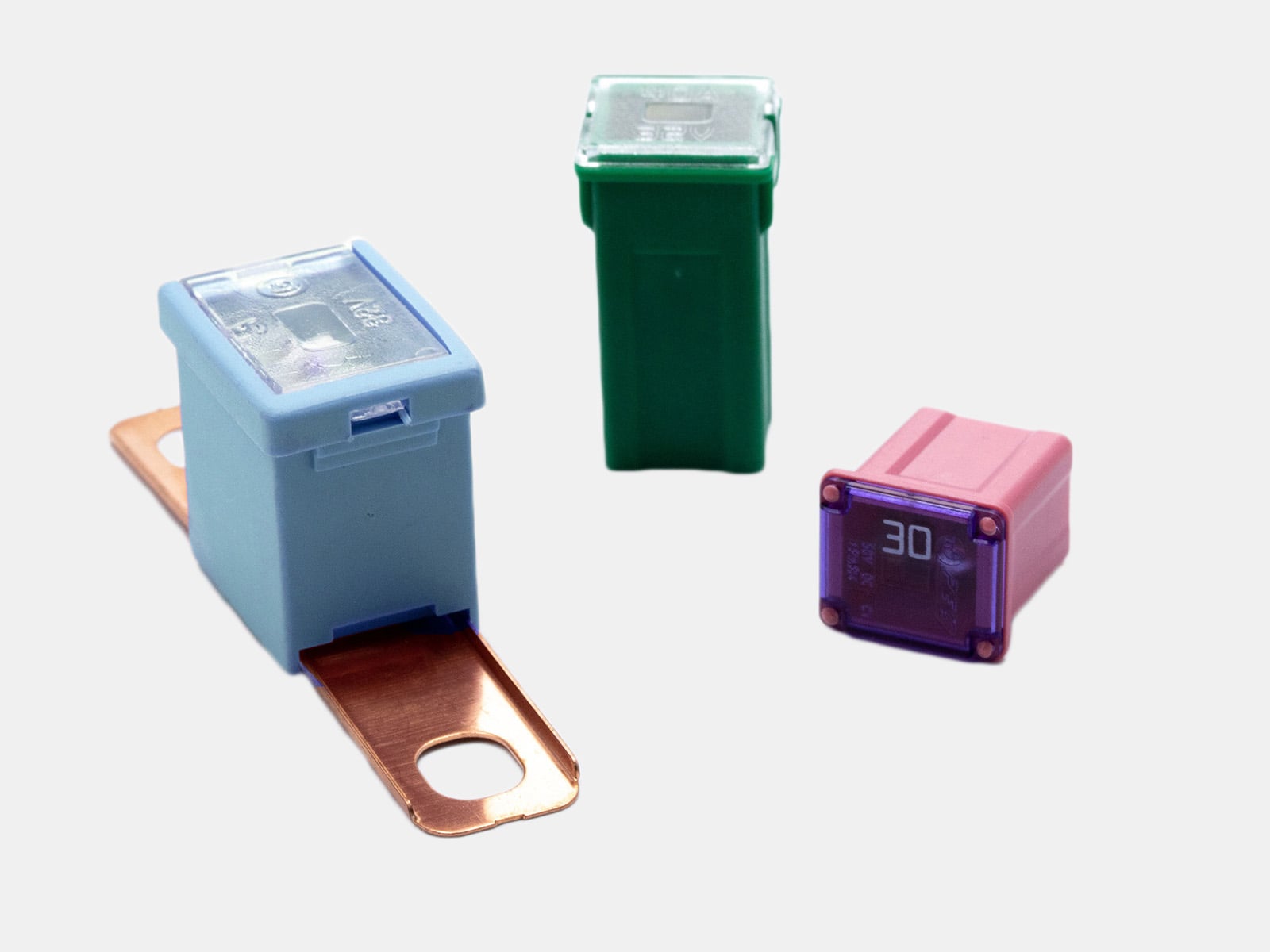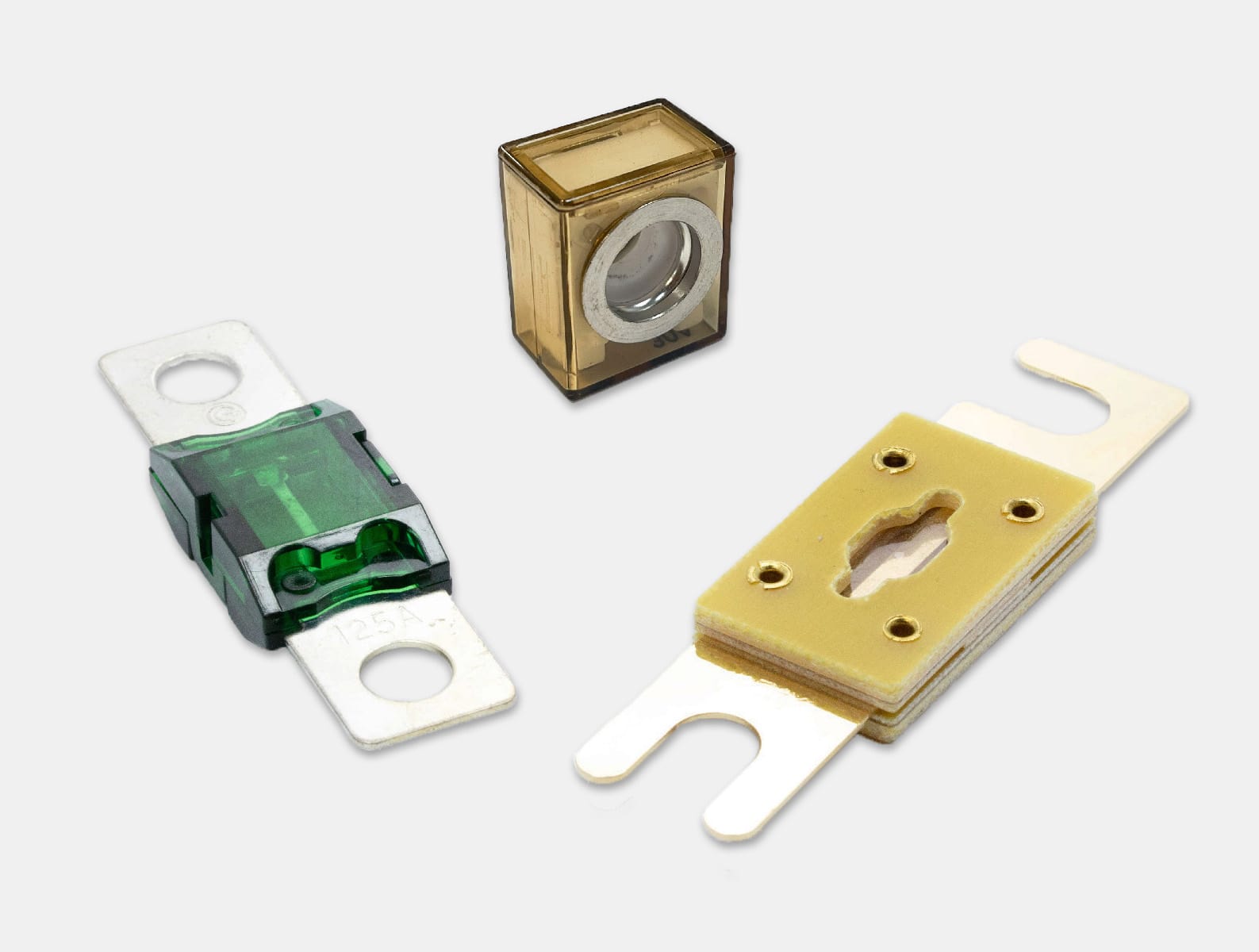Automotive Fuse Types: Complete Overview

Whether you’re maintaining a modern car, designing a new RV electrical system, or restoring a classic vehicle, understanding automotive fuses is essential for safe and reliable circuit protection. Each fuse type serves a specific purpose depending on voltage, current rating, mounting style, and space constraints. See our full Fuse Selection Guide for complete context.
Automotive Blade Fuses
Blade fuses are the most widely used fuse type in modern vehicles and DC-powered systems. They’re known for compact size, ease of installation, and color-coded identification.

Blade Fuse Applications
Automotive & Transportation
- Headlights & taillights
- Windshield wipers
- Power windows & locks
- Infotainment systems
- 12V outlets and auxiliary circuits
Marine, RV & Off-Grid
- Battery charging systems
- Pumps & ventilation fans
- Solar panel connections
- DC lighting
Industrial & Robotics
- Control wiring
- Relays, solenoids, and DC motors
- Battery management systems
- Small actuators
Blade fuses are ideal for accessory-level circuit protection — helping isolate failures without disabling the entire system.
Blade Fuse Mounting Options
Blade fuses aren’t just versatile electrically—they also offer flexible mounting options to fit nearly any automotive, emergency vehicles, or RV application. Choosing the right mounting device ensures easy installation, maintenance, and reliable circuit protection.
Blade fuses aren’t just versatile electrically—they also offer flexible mounting options to fit nearly any automotive, emergency vehicles, or RV application. Choosing the right mounting device ensures easy installation, maintenance, and reliable circuit protection.
Common mounting options include:
In-line Fuse Holders
- Ideal for wiring harnesses and retrofits
- Connects directly into a wire or cable for overcurrent protection
- Easy to replace without disassembling panels
- Learn more in our In-Line Fuse Holder Customization Guide
Fuse Blocks
- Surface-mounted solution for multiple circuits
- Allows centralized protection for automotive, RV, or industrial applications
- Offers quick connection via screw terminals or quick-connect tabs
- See our detailed guide on How to Choose Blade Fuse Blocks
Fuse Taps / Add-A-Fuses
- Enable adding a secondary circuit without cutting main wiring
- Perfect for accessories like dash cams, auxiliary lights, or GPS devices
- Minimizes splicing and preserves original wiring integrity
- Read more in Add-A-Fuse & Fuse Taps: Adding a New Circuit
Blade Fuse FAQs
What Do Fuse Colors Mean?
Automotive fuses are color-coded by amperage rating, making it easy to identify the correct fuse and prevent improper installation. Common fuse colors include:
- Red – 10A: Interior lights
- Blue – 15A: Windshield wipers, heated seats
- Yellow – 20A: Power sockets, audio systems
- Green – 30A: Heavy-duty accessories like sunroofs
Use Fuses with Built-In LED Indicators
Identifying a blown fuse can be frustrating, especially in tight panels or dim lighting. OptiFuse fuses with LED indicators light up bright red when blow, making inspection fast and hassle-free.
Did You Know Blade Fuses Aren’t Just for 12V Systems?
Blade fuses now support higher voltage systems (up to 80VDC and 250VAC), making them suitable for:
- Solar energy storage systems
- Electric vehicles and hybrids
- Industrial DC control circuits
Automotive Link Fuses
Automotive link fuses are used extensively across the transportation industry — from passenger cars to heavy-duty trucks. They protect high-current systems, including battery feeds, alternators, and main power distribution circuits, ensuring reliability and safety for OEM and aftermarket applications.

These fuses typically come in three main types:
PAL Style Fuses (TFL Series)
PAL fuses are high-current, bolt-down or plug-in fuses used in OEM and heavy-duty applications. They typically handle 20A–140A at 32VDC and are color-coded for quick amperage identification.
- Japanese vehicles (Toyota, Honda, Nissan)
- Hybrid electric vehicles
- Trucks and heavy-duty platforms
- Battery and alternator connections
- Junction blocks near battery terminals
PAL Style Fuse Mounting Styles
Horizontal bolt-down (Male)
Long horizontal bolt-down (Male)
Vertical bolt-down (Male)
Locking terminal (low amp) (Female)
Locking terminal (high amp) (Female)
Smallest form factor (Female)
Standard bolt installation
Extended spacing or alignment
Perpendicular panel mounting
Plug-in applications
High-current plug-in use
Tight clearances or compact harnesses
JCase Style Fuses (FMX Series)
JCase fuses (OptiFuse FMX and FMX-LP) are medium-current blade fuses designed for under-hood circuits. They support 20A–60A at 32VDC or 58VDC and feature a compact plug-in blade design. Optional low-profile and LED-indicating versions are available. These fuses are color-coded for easy amperage identification and provide reliable protection for critical vehicle electronics in medium-current circuits.
- ABS modules
- Radiator fans
- Fuel pumps
- Power seats
- Central fuse boxes
MCase Style Fuses (FMX-M, FMX-MS Series)
MCase fuses (OptiFuse FMX-M and FMX-MS) are miniature blade fuses for compact spaces in modern vehicles. They handle 15A–60A at 58VDC, feature plug-in female blade mounting, and come in slotted or standard terminal styles for easy installation and removal. They are also color-coded for easy amperage identification.
- Heated seats
- Power windows
- Electronic control modules
- Interior accessory systems
Why Use Link Fuses Instead of Blade Fuses?
While standard blade fuses are convenient, automotive link fuses such as PAL, JCase, and MCase provide superior protection in high-current applications (20A–140A).
Advantages of automotive link fuses:
- Higher current handling — up to 140A
- Better heat dissipation thanks to bolt-down designs— ideal for battery and alternator circuits
- OEM-level reliability for critical systems
- Flexible mounting options — bolt-down and plug-in styles
Automotive Bolt-On Fuses
For extreme current handling (up to 800A), bolt-on fuses are the go-to. They’re designed for secure installation, vibration resistance, and fast or time-delay protection, these fuses are ideal for battery, alternator, and main power distribution circuits in passenger vehicles, commercial trucks, EV/hybrid platforms, and industrial equipment.

Bolt-On Fuse Applications
- Battery & starter protection
- Alternator output circuits
- Winches, compressors, and pumps
- Main EV/hybrid power circuits
- Material handling equipment
Bolt-On Fuse Styles & Specs
MIDI
MEGA
Limiter
MID, MIDA
MGGA
ANE, ANF
Up to 200A
Up to 500A
Up to 800A
Bolt-On Fuses Additional Benefits
- The MIDI style fuses feature 30 mm bolt spacing and fast-acting protection. They operate at 32VDC (MID) or 58VDC (MIDA) with an interrupting rating of 1,000A. Their translucent body allows visual inspection of the element, and they follow industry-standard color coding. The operating temperature range is –40°C to 125°C.
- The MEGA style fuses offer 50.8 mm bolt spacing and are available in 100A–300A (MGGA) or 40A–500A (MGGA-B) at 32VDC. Interrupting ratings are 1,000A for MGGA and 2,000A for MGGA-B. They feature a slow-blow design. MGGA has a translucent body for visual inspection, and standard color coding.
- Limiter fuses have 61.8 mm spacing and provide fast-acting protection for 35A–800A (ANF) or 35A–400A (ANE) at 32VDC, with a 2,500A interrupting rating. The ignition-protected ANE-M version covers 40A–600A at 125VDC. These fuses feature a fast-acting limiter style.
Bolt-On Fuse FAQs
Fast-Acting vs. Time Delay Fuses: What’s the Difference?
Choosing between fast-acting and time-delay fuses is crucial:
- Fast-Acting Fuses blow instantly, ideal for sensitive electronics needing immediate circuit interruption.
- Time-Delay (Slow-Blow) Fuses handle short spikes (inrush current) without blowing, perfect for inductive loads like motors, compressors, and pumps.
Match your fuse type to your equipment’s startup characteristics to minimize nuisance trips and maximize circuit protection.
Automotive Glass Fuses
Though more common in older or specialty vehicles, automotive glass fuses are still a reliable option for compact, clear-body, and quick-inspection fuse needs.

Glass Fuse Applications
- Classic cars and motorcycles
- Boats, RVs, and ATVs
- Vintage fuse panels (pre-blade)
- Aftermarket wiring harnesses
- Accessory circuits (lights, USB chargers)
Glass Fuse Use Cases and Features
- AGA (FSH): Designed for compact circuits, they are the smallest size, making them ideal for tight spaces.
- AGW (FSW): Suitable for general low-voltage circuits, they are slightly larger than 1AG fuses and provide dependable protection.
- AGX (FSX): Perfect for vintage vehicle panels.
- AGU (FSG): Intended for high-current accessories, they handle higher-current loads safely.
- SFE (FSO): OEM-specific fuses with lengths that increase according to amperage, designed to match manufacturer specifications.
- GBC (APG): Common in older European cars, they feature an easy-grip shape for straightforward installation and removal.
Final Summary: How to Choose the Right Automotive Fuse
Choosing the correct automotive fuse ensures reliable performance, protects your vehicle’s electrical system, and keeps your equipment safe. Here’s a quick breakdown to simplify your selection:
Blade Fuses – Best for Accessory-Level Circuits
Blade fuses (0.5A–120A) are perfect for everyday accessory circuits: interior lighting, infotainment systems, or power sockets. Their easy plug-in design and color-coded bodies simplify maintenance and replacement.
Automotive Link Fuses (PAL, JCase, MCase) – OEM & High-Current Applications
For circuits requiring OEM-level quality and moderate-to-high current protection (15A–140A), automotive link fuses such as PAL, JCase, and MCase are ideal. Available in bolt-down and plug-in mounting, these robust fuses excel in battery feeds, alternators, and main power distribution blocks.
Bolt-On Fuses – Extreme Current Handling
Bolt-on fuses (30A–800A) provide heavy-duty protection for very high-current applications. They’re designed for critical circuits like starters, alternators, and electric vehicle main systems, offering vibration-resistant mounting and reliable performance under demanding conditions.
Glass Fuses – Ideal for Vintage & Custom Builds
Finally, glass fuses (1A–40A+) offer transparent, quick-inspection protection ideal for vintage cars, motorcycles, boats, or custom-built wiring harnesses. Their classic design simplifies visual diagnostics, making them perfect for older or specialty vehicles.
Sebastian Castañeda, Application Engineer at OptiFuse, supports customers with technical solutions, custom circuit protection design, and training. He provides tailored guidance and shares expert insights on the OptiFuse Blog.



